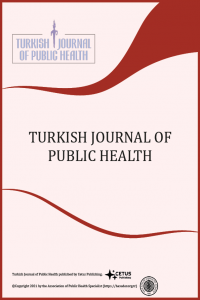Elazığ (Türkiye) İl’inin farklı bölgelerinde yeraltı suları ve yerüstü sularındaki nitrat düzeylerine dayalı sağlık risk değerlendirmesi
Amaç: Bu çalışmada, Elazığ ilinin 65 farklı yerinden alınan yeraltı ve yerüstü su örneklerindeki nitrat konsantrasyonunun, bu bölgelerde yaşayan insanlar için olası sağlık tehlikelerinin araştırılması amaçlanmıştır. Yöntem: Kesitsel bir araştırma olan bu çalışmada, içme suyundaki nitrat düzeylerine spektrofotometrik olarak bakılmış olup içme suyu yoluyla yüksek nitrat alımının, yetişkinler, çocuklar ve bebekler üzerindeki olası sağlık risk değerlendirmesi, USEPA sağlık tehlike modeli (HQ) kullanılarak yapılmıştır. Bulgular: Su numunelerinin nitrat seviyeleri ortalaması 8.99±16.77 mg/L olarak hesaplanmıştır. Örnekleme noktalarının %6'sında Türk standartlarında (50 mg/L) ve Dünya Sağlık Örgütü (50 mg/L) standartlarında önerilen sınır değerlerden daha yüksek konsantrasyonlara sahip olduğu ortaya çıkmıştır. Nitratın, kronik günlük alımı (CDI), yetişkinler, çocuklar ve bebekler için sırasıyla 0.25±0.47, 0.67±1.25 ve 0.71±1.34 mg/kg/gün’dür. Tehlike katsayısı (HQ) değeri yetişkinler için 0.16±0.29, çocuklar için 0.42±0.78 ve bebekler için 0.44±0.83 olarak hesaplanmıştır. Sonuç: Tehlike katsayısı (HQ) değerleri, Elazığ ilinin %9.30’u yetişkin, %18.60’ı çocuk ve %20.93’ü bebek nüfusunun aşırı nitrat kullanımı nedeniyle kronik toksisite riski altında olduğunu göstermektedir. Bu nedenle, nitrat değerinin yüksek olduğu yerlerde su kaynaklarını korumak için gerekli tüm çevresel güvenlik önlemleri alınmalıdır.
Anahtar Kelimeler:
sağlık risk değerlendirmesi, İçme suyu, nitrat, tehlike katsayısı, Elazığ
Health risk assessment based on nitrate levels in ground and surface waters in different sites of the Elazığ Province, Turkey
Objective: The aim of this study was to investisgate the nitrate concentration levels in groundwater and surface water samples collected from 65 distinct locations in the Elazığ Province of Turkey. In doing so, it was aimed to evaluate the possible health implications on the poupulations living in these areas. Method: In this cross-sectional study, the nitrate levels in drinking water were analyzed spectrophotometrically and the possible health risk assessment of adults, children and infants through drinking water was ascertained using the USEPA health hazard model (HQ). Results: The mean nitrate levels of the water samples were calculated as 8.99 ± 16.77 mg/L. It was found that 6% of the sampling points had higher concentrations than the recommended limit values by Turkish (50 mg / L) and World Health Organization (50 mg / L) standards. Chronic daily intake of nitrate (CDI) was 0.25 ± 0.47, 0.67 ± 1.25 and 0.71 ± 1.34 mg/kg/day for adults, children and infants, respectively. The hazard quotient (HQ) was calculated as 0.16 ± 0.29 for adults, 0.42 ± 0.78 for children and 0.44 ± 0.83 for infants. Conclusion: The hazard quotient (HQ) values reveal that 9.30% of adults, 18.60% of children and 20.93% of the infant population of Elazığ are at a higher risk of chronic toxicity through excess nitrate intake. Therefore, where the nitrate value is measured as high, all necessary environmental safety precautions should be taken to protect water resources.
Keywords:
Hazard quotient, health risk assessment, Drinking water, nitrate, Elazığ,
___
- 1. IARC (2010) Ingested nitrate and nitrite, and cyanobacterial peptide toxins, vol 94. IARC Press, International Agency for Research on Cancer, Lyon.2. Keramati H, Ghorbani R, Fakhri Y, Khaneghah AM, Conti GO, Ferrante M, Ghaderpoori M, Taghavi M, Baninameh Z, Bay A. Radon 222 in drinking water resources of Iran: a systematic review, metaanalysis and probabilistic risk assessment (Monte Carlo simulation). Food Chem Toxicol, 2018; 115,460–4693.Eziz M, Mohammad A, Mamut A, Hini G. A human health risk assessment of heavy metals in agricultural soils of Yanqi Basin, Silk Road Economic Belt, China. Hum Ecol Risk Assess, 2018; 24,1–15.
- Başlangıç: 2003
- Yayıncı: Halk Sağlığı Uzmanları Derneği
Sayıdaki Diğer Makaleler
Emine ÖNCÜ, Sümbüle KÖKSOY VAYISOĞLU, Yasemin GÜVEN, Gamze AKTAŞ, Halil CEYHAN, Esra KARAKUŞ
Whye Lian CHEAH, Ching Thon CHANG, Helmy HAZMİ, Grace, Woei Feng KHO
Kanada Saskatchewan’da halk sağlığı sorunları ve bulaşıcı olmayan hastalıklar
Muhammad SİDDİQUİ, Muhammad Owais AZİZ
Avrupa’da dolaşan koleranın gölgesinde, Istanbul uluslararası sağlık konferansı, 1866
